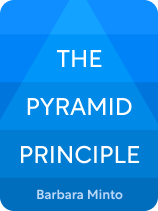

This article is an excerpt from the Shortform book guide to "The Pyramid Principle" by Barbara Minto. Shortform has the world's best summaries and analyses of books you should be reading.
Like this article? Sign up for a free trial here.
What’s the key to being a better writer? How does Barbara Minto’s conclusions-first pyramid improve your writing?
In her book The Pyramid Principle, Barbara Minto solves the problem of unclear writing. She ensures that you should express your conclusions first, which she backs up with her Pyramid Principle style of writing.
Keep reading to learn how to be a better writer by structuring your papers as a pyramid.
The Elements of the Conclusions-First Pyramid
Let’s explore Barbara Minto’s Pyramid Principle, which we’ll call the Conclusions-First Pyramid. Here, we’ll visualize this pyramid and explain each of its labeled elements to learn how to be a better writer:
- The Peak: The top of the pyramid, which we call the Peak, represents the beginning of your written piece. This is where you present your piece’s main conclusion, which we’ll call the Peak Conclusion.
- Tier 1: After your Peak Conclusion comes the ideas it summarizes—the ideas that support it. These supporting ideas are the “bricks” that hold up the Peak Conclusion. We’ll call the row these supporting ideas occupy Tier 1.
(Shortform note: Minto isn’t the first writing expert to model their writing after a pyramid: Since the early 20th century, journalists have been structuring their writing using an inverted pyramid model (one that’s wide at the top and pointed at the bottom). Like Minto’s model for Pyramid Writing, this inverted pyramid has writers begin their pieces with the most important ideas. In this model, the wide base of the pyramid represents the beginning of a news story, where you share the most important takeaways. Less important information comes next: This is represented by the narrowing of the pyramid.)
Let’s explore how the structure of your Conclusions-First Pyramid may vary depending on the length and complexity of the piece you’re writing.
Structure 1: A Two-Tier Pyramid
Minto explains that you can plan out brief, simple pieces of writing using a pyramid with only two tiers. For example, the earlier piece about employee burnout needs only two tiers: an opening sentence that shares the Peak Conclusion, followed by a pair of Tier 1 sentences that share examples supporting that conclusion.
(Shortform note: What are some ideal scenarios for using a two-tier pyramid to structure your writing? You might think of the two-tier pyramid as a model for any paragraph that fits within a larger piece of writing. The conclusion would form the paragraph’s first sentence, and the supporting ideas would follow. Other simple forms of writing that you could structure using a two-tier pyramid include comments on online videos and social media posts, descriptions of items you’re selling online, and letters.)
Structure 2: A Three-Tier Pyramid
By contrast, Minto claims that multi-page pieces of writing (such as reports or books) need a pyramid with more than two tiers. Longer, more complex pieces of writing require that you also support the ideas in Tier 1. To accomplish this, add another tier below Tier 1. As shown below, when you add this new tier (which we’ll call Tier 2), the ideas in Tier 1 become conclusions for Tier 2’s supporting ideas.
For example, imagine you’re writing a two-page report. You begin the report with an introduction paragraph in which you share your Peak Conclusion and preview your Tier 1 conclusions that support the main conclusion. Then, you divide the rest of your piece into two sections: one for Conclusion A and another for Conclusion B. Each section features two paragraphs: one for each idea that supports the Tier 1 conclusions. These paragraphs form Tier 2.
(Shortform note: Although Minto doesn’t explain this explicitly, the structure she proposes for multi-paragraph pieces of writing features pyramids within a pyramid. Your entire piece forms a large pyramid topped with a conclusion that summarizes all the piece’s ideas. Within this large pyramid are smaller pyramids: Tier 1 conclusions with supporting evidence branching out beneath them. For instance, the diagram above includes three pyramid structures: a large pyramid topped by the Peak Conclusion, a second pyramid topped by Conclusion A, and a third pyramid topped by Conclusion B. Adding another tier below Tier 2 would create an additional set of smaller pyramids.)
Next, let’s explore why structuring your writing using a Conclusions-First Pyramid improves your reader’s experience.
The Reader’s Experience of Pyramid Writing
Minto argues that the structure of Pyramid Writing helps you become a better writer because it meets your reader’s need for logical clarity. Because you begin your writing by sharing your Peak Conclusion, your reader won’t have to form conclusions as they read. Instead, they can focus on fully understanding your ideas. By the time they reach the end of your piece, they’ll have a clear understanding of your ideas and overall argument.
(Shortform note: Because Pyramid Writing meets readers’ need for logical clarity, this type of writing may also free up your reader’s mind to engage more deeply with your ideas. In How to Read a Book, Mortimer Adler and Charles Van Doren claim that when readers aren’t focused on simply comprehending the text, they can engage in more sophisticated types of reading. One type of sophisticated reading is analytical reading: when you thoroughly understand an author’s ideas and critique those ideas.)
Next, let’s examine what it’s like to create Pyramid Writing.
The Writer’s Experience With Pyramid Writing
Minto explains that Pyramid Writing has you brainstorm and organize your ideas before you write them. As you generate new ideas during the brainstorming stage, you deposit them into the Conclusions-First Pyramid. Then, when it comes time to write, your ideas are already organized in a conclusions-first structure.
(Shortform note: Research supports Minto’s claim that it’s beneficial to brainstorm and organize your ideas before you write. Writers who take time to generate ideas and plan their structure before writing produce more organized final pieces. Furthermore, this process makes writing less mentally taxing. Experts theorize that brainstorming your ideas in advance reduces the strain on your working memory (your brain’s system for temporarily storing information) because it separates idea generation and organizing from the act of writing. If you try to generate, organize, and write ideas at the same time, your working memory—which has limited capacity—may become overloaded.)
In the following sections, we’ll break down the steps of using this pyramid structure to improve your writing process and its final outcome. To reflect Minto’s claim that you should separate brainstorming from writing, we’ve broken her process into these two stages.

———End of Preview———
Like what you just read? Read the rest of the world's best book summary and analysis of Barbara Minto's "The Pyramid Principle" at Shortform.
Here's what you'll find in our full The Pyramid Principle summary:
- How to write so clearly that you can get a point across within 30 seconds
- How to write a clear, compelling introduction, body, and conclusion
- Why you should always start your prose with your conclusion and work backward






